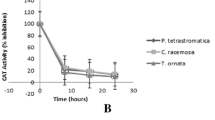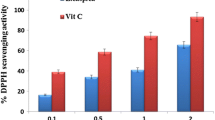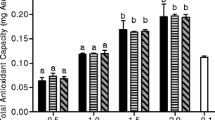Abstract
Seaweeds have been used as a source of traditional medicine worldwide for the treatment of various ailments, mainly due to their ability to quench the free radicals. The present study aims at evaluating the protective effect of methanolic extract of Gelidiella acerosa, an edible red seaweed against 2,3,7,8-tetrachlorodibenzo-p-dioxin (TCDD)-induced toxicity in peripheral blood mononuclear cells (PBMC). For evaluating the protective effect of G. acerosa, PBMC were divided into four groups: vehicle control, TCDD (10 nM), TCDD + G. acerosa (300 μg/ml), and G. acerosa alone treated. Scavenging of intracellular reactive oxygen species (ROS) induced by TCDD was assessed by the dichloro-dihydro-fluorescein diacetate (DCFH-DA) method. Alterations at macromolecular level were quantified through lipid peroxidation (LPO) level, protein carbonyl content (PCC) level, and comet assay. The cellular morphology upon TCDD toxicity and G. acerosa treatment was obtained by light microscopy and histopathological studies. The chemical composition present in the methanolic extract of G. acerosa was determined by gas chromatography-mass spectrometry (GC-MS) analysis. The results reveal that 10 nM TCDD caused significant (P < 0.05) reduction in cell viability (94.10 ± 0.99), and treatment with 300 μg/ml extract increased the cell viability (99.24 ± 0.69). TCDD treatment resulted in a significant increase in the production of ROS, LPO (114 ± 0.09), and PCC (15.13 ± 1.53) compared to the control, whereas co-treatment with G. acerosa significantly (P < 0.05) mitigated the effects. Further, G. acerosa significantly (P < 0.05) prevented TCDD-induced genotoxicity and cell damage. GC-MS analysis showed the presence of n-hexadecanoic acid (retention time (RT) 13.15), cholesterol (RT 28.80), α-d-glucopyranose, 4-O-α-d-galactopyranosyl (RT 20.01), and azulene (RT 4.20). The findings suggest that G. acerosa has a strong protective ability against TCDD-induced cytotoxicity, oxidative stress, and DNA damage.







Similar content being viewed by others
References
Aly HAA, Domenech O (2009) Cytotoxicity and mitochondrial dysfunction of 2,3,7,8-tetrachlorodibenzo-p-dioxin (TCDD) in isolated rat hepatocytes. Toxicol Lett 191:79–87
Aly HAA, Khafagy RM (2011) 2,3,7,8-tetrachlorodibenzo-p-dioxin (TCDD)-induced cytotoxicity accompanied by oxidative stress in rat Sertoli cells: possible role of mitochondrial fractions of Sertoli cells. Toxicol Appl Pharm 252:273–280
Baccarelli A, Pesatori AC, Masten SA, Patterson DG, Needhame LL, Mocarelli P, Caporaso NE, Consonni D, Grassman JA, Bertazzi PA, Land MT (2004) Aryl-hydrocarbon receptor-dependent pathway and toxic effects of TCDD in humans: a population-based study in Seveso, Italy. Toxicol Lett 149:287–293
Bai X, Chen Y, Chen W, Lei H, Shi G (2011) Volatile constituents, inorganic elements and primary screening of black coral cigarette holders. Mar Drugs 9:863–878
Byers JP, Masters K, Sarver JG, Hassoun EA (2006) Association between the levels of biogenic amines and superoxide anion production in brain regions of rats after subchronic exposure to TCDD. Toxicology 228:291–298
Chen ZH, Hurh YJ, Na HK, Kim JH, Chun YJ, Kim DH, Kang KS, Cho MH, Surh YJ (2004) Resveratrol inhibits TCDD-induced expression of CYP1A1 and CYP1B1 and catechol estrogen-mediated oxidative DNA damage in cultured human mammary epithelial cells. Carcinogenesis 25:2005–2013
Ciftci O, Ozdemir I (2010) Protective effects of quercetin and chrysin against 2,3,7,8-tetrachlorodibenzo-p-dioxin (TCDD) induced oxidative stress, body wasting and altered cytokine productions in rats. ImmunoPharm Immunot 1-5
Devi PK, Suganthy N, Kesika P, Pandian KS (2008) Bioprotective properties of seaweeds: in vitro evaluation of antioxidant activity and antimicrobial activity against food borne bacteria in relation to polyphenolic content. BMC Complement Altern Med 8:1–11
Gandhi NM (2013) Baicalein protects mice against radiation-induced DNA damages and genotoxicity. Mol Cell Biochem 379:277–281
Ganesan P, Kumar CS, Bhaskar N (2008) Antioxidant properties of methanol extract and its solvent fractions obtained from selected Indian red seaweeds. Bioresource Technol 99:2717–2723
Hassoun EA, Li F, Abushaban A, Stohs SJ (2002) Production of superoxide anion, lipid peroxidation and DNA damage in the hepatic and brain tissues of rats after subchronic exposure to mixtures of TCDD and its congeners. J Appl Toxicol 21:211–219
Hung YC, Huang GS, Sava VM, Blagodarsky VA, Hong MY (2006) Protective effects of tea melanin against 2,3,7,8-tetrachlorodibenzo-p-dioxin-induced toxicity: antioxidant activity and aryl hydrocarbon receptor suppressive effect. Biol Pharm Bull 29:2284–2291
Ilavarasi K, Kiruthiga PV, Pandian SK, Devi K (2011) Hydroxytyrosol, the phenolic compound of Olive oil protects human PBMC against oxidative stress and DNA damage mediated by 2,3,7,8-TCDD. Chemosphere 84:888–893
Inouye K, Pan X, Imai N, Ito T, Takei T, Tohyama C, Nohara K (2005) T cell-derived IL-5 production is a sensitive target of 2,3,7,8-tetrachloradibenzo-p-dioxin (TCDD). Chemosphere 60:907–913
Ishimura R, Kawakami T, Ohsako S, Tohyama C (2009) Dioxin-induced toxicity on vascular remodeling of the placenta. Biochem Pharmacol 77:660–669
Kala SMJ, Balasubramanian T, Soris PT, Mohna VR (2011) GC-MS determination of bioactive components of Eugenia singampattiana Bedd. Int J ChemTech Res 3:1534–1537
Kiruthika PV, Pandian SK, Devi KP (2010) Silymarin protects PBMC against B(a)P induced toxicity by replenishing redox status and modulating glutathione metabolizing enzymes—an in vitro study. Toxicol Appl Pharm 247:116–128
Knerr S, Schaefer J, Both S, Mally A, Dekant W, Schrenk D (2006) 2,3,7,8 Tetrachlorodibenzo-p-dioxin induced cytochrome P450s alter the formation of reactive oxygen species in liver cells. Mol Nutr Food Res 50:378–384
Krishnamurthy V, Joshi HY (1970) Check list of Indian marine algae. Bhavnagar, India: Central Salt and Marine Chemicals Research Institute 1-36
Landi MT, Bergen AW, Baccarelli A, Donald G, Patterson JR, Grassman J, Minassian MT, Mocarelli P, Caporaso N, Scott A, Angela MC, Pittman GS, Bell DA (2005) CYP1A1 and CYP1B1 genotypes, haplotypes, and TCDD-induced gene expression in subjects from Seveso, Italy. Toxicology 207:191–202
Lang DS, Becker S, Devlin RB, Koren HS (1996) 2,3,7,8-TCDD induces cytochrome P450 enzyme activity but not proliferation or phenotypical changes in human peripheral blood lymphocytes. Toxicol Lett 88:317–325
Latchoumycandane C, Chitra KC, Mathur PP (2003) 2, 3, 7, 8-Tetrachlorodibenzo-p -dioxin (TCDD) induces oxidative stress in the epididymis and epididymal sperm of adult rats. Arch Toxicol 77:280–284
Lin PH, Lin CH, Huang CC, Chuang MC, Lin P (2007) 2,3,7,8-Tetrachlorodibenzo-p-dioxin (TCDD) induces oxidative stress, DNA strand breaks, and poly(ADP-ribose) polymerase-1 activation in human breast carcinoma cell lines. Toxicol Lett 172:146–158
Lowry OH, Rosenberg NJ, Farr AL, Randal RJ (1951) Protein measurement with the Folin-phenol reagent. J Biol Chem 193:265–275
Martin FJS, Pedro M, Salguero F, Jaime M, Merino JM (2010) 2,3,7,8-Tetrachlorodibenzo-p-dioxin induces apoptosis in neural growth factor (NGF)-differentiated pheochromocytoma PC12 cells. NeuroToxicology 31:267–276
Nabavi SM, Nabavi SF, Eslami S, Moghaddam AH (2012) In vivo protective effects of quercetin against sodium fluoride-induced oxidative stress in the hepatic tissue. Food Chem 132:931–935
Namvar F, Mohamed S, Fard SG, Behravan J, Mustapha NM, Alitheen NBM, Othman F (2012) Polyphenol-rich seaweed (Eucheuma cottonii) extract suppresses breast tumour via hormone modulation and apoptosis induction. Food Chem 130:376–382
Olson JR (1994) Pharmacokinetics of dioxin and related chemicals. In Dioxins and health. 3rd edition. Edited by Schecter A. Hoboken, NJ: Plenum Press 163-167.
Oza RM, Zaidi SH (2001) A revised checklist of Indian Marine Alage. Central salt and marine chemicals research institute. Bhavnagar, India, pp 1–296
Park JY, Shigenaga MK, Ames BN (1996) Induction of cytochrome P4501A1 by 2,3,7,8-tetrachlorodibenzo-p-dioxin or indolo(32-b)carbazole is associated with oxidative DNA damage. Proc Natl Acad Sci USA 93:2322–2327
Prasad K, Siddhanta AK, Ganesan M, Ramavat BK, Jha B, Ghosh PK (2007) Agars of Gelidiella acerosa of west and southeast coasts of India. Bioresource Technol 98:1907–1015
Skene SA, Dewhurst IC, Greenberg M (1989) Polychlorinated dibenzo-p-dioxins and polychlorinated dibenzofurans: the risks to human health. Hum Toxicol 8:173–203
Sola R, Ville AEL, Richard JL, Motta C, Bargallo MJ, Girona J, Masana L, Jacotot B (1997) Oleic acid rich diet protects against the oxidative modification of high density lipoprotein. Free Radi Biol Med 22:1037–1045
Suganthy N, Nisha AS, Pandian KS, Devi PK (2010) Antioxidant and metal chelating potential of the solvent fractions of Gelidiella acerosa, the red algae inhabiting South Indian coastal area. Biomed Pharmacother 19:17–21
Sul D, Kim HS, Cho EK, Lee M, Kim HS, Jung WW, Hwang KW, Park SY (2009) 2,3,7,8-TCDD neurotoxicity in neuroblastoma cells is caused by increased oxidative stress, intracellular calcium levels, and tau phosphorylation. Toxicology 255:65–71
Turkez H, Geyikoglu F, Mokhtar Y (2012) Ameliorative effect of docosahexaenoic acid on 2,3,7,8-tetrachlorodibenzo- p-dioxin-induced histological changes, oxidative stress, and DNA damage in rat liver. Toxicol Ind Health 28:687–696
Uttara B, Singh AV, Zamboni P, Mahajan RT (2009) Oxidative stress and neurodegenerative diseases: a review of upstream and downstream antioxidant therapeutic options. Curr Neuropharmacolo 7:65–74
Yang JH, Lee HG (2010) 2,3,7,8-Tetrachlorodibenzo-p-dioxin induces apoptosis of articular chondrocytes in culture. Chemosphere 79:278–284
Yuan VY, Bone ED, Carrington FM (2005) Antioxidant activity of Dulse (Palmaria palmate) seaweed extract evaluated in vitro. Food Chem 91:485–494
Acknowledgments
KPD wishes to thank ICMR, India [IRS ID 2007-02200] for the financial support. The authors also gratefully acknowledge the computational and bioinformatics facility provided by the Alagappa University Bioinformatics Infrastructure Facility (funded by the Department of Biotechnology, Government of India; Grant No. BT/BI/25/001/2006).
Conflict of interest
The authors declare that there are no conflicts of interest.
Author information
Authors and Affiliations
Corresponding author
Additional information
Responsible editor: Philippe Garrigues
Rights and permissions
About this article
Cite this article
Kalaiselvan, I., Senthamarai, M. & Kasi, P.D. 2,3,7,8-TCDD-mediated toxicity in peripheral blood mononuclear cells is alleviated by the antioxidants present in Gelidiella acerosa: an in vitro study. Environ Sci Pollut Res 23, 5111–5121 (2016). https://doi.org/10.1007/s11356-014-3799-2
Received:
Accepted:
Published:
Issue Date:
DOI: https://doi.org/10.1007/s11356-014-3799-2




